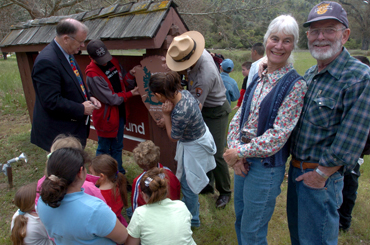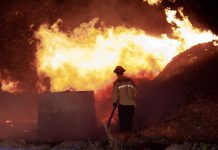
As wildlife habitat dwindles, Pinnacles National Monument adds
2,000 acres and helps out the red-legged frog
Not all is bleak for the red-legged frog and other diminishing
critters of the wild.
The long awaited deed transfer of the Kingman Ranch to the
Pinnacles National Monument in south San Benito County was
celebrated Tuesday as park officials honored the many who made the
1,967-acre acquisition possible.
As wildlife habitat dwindles, Pinnacles National Monument adds 2,000 acres and helps out the red-legged frog
Not all is bleak for the red-legged frog and other diminishing critters of the wild.
The long awaited deed transfer of the Kingman Ranch to the Pinnacles National Monument in south San Benito County was celebrated Tuesday as park officials honored the many who made the 1,967-acre acquisition possible.
In a time when habitat loss continues to threaten wildlife, Rep. Sam Farr, D-Carmel, took pleasure in wrenching tight an official National Parks marker to a sign at the park campground – an area that until then had been outside the boundaries of the Pinnacles. The symbolic gesture made official an expansion 12 years in the making, one that ensures the former ranchland of valley oak savanna stays protected under the National Park Service in perpetuity.
“What a beautiful day for America,” Farr told a crowd of spectators earlier. “In an era when there is a lot of uncertainty in the world, even in our own lives, it’s nice to have a little permanence.”
The addition of the Kingman Ranch at the east entrance of the Pinnacles boosts the park’s size to 26,425 acres, but it was a long and arduous undertaking to make it happen. Peggy and Stuart Kingman, who now live in Tuolumne County, said between their land partners and all the heirs, the property would have had to be divided 14 ways had they not been able to sell it to the park. The couple, along with several other VIPs involved with the deal, was on hand for the ceremony, which was attended by the 15 or so grade school students of nearby Jefferson School.
“Who knows what would have happened to the land?” Stuart Kingman said to the audience, as he stood on the porch of the campground store.
“I get very emotional about a piece of property,” Peggy Kingman said when she addressed the park-goers. “It grows on you and sustains you. This opportunity is too scarce in this day and age.”
When the Kingmans initially made the decision to sell the property to the Pinnacles in the mid 1990s, park service officials were thrilled. The problem was that the National Park Service, faced with increasing budget cuts, could not afford to buy the land for even half of what it was worth. Some five different Pinnacle park superintendents grappled with the bureaucracy of the acquisition throughout the years. One of those was former superintendent Steve Schackelton, who now serves at Yosemite National Park.
“They (the Kingmans) could have sold it to developers and made a fortune,” Shackelton said. “There’s nothing wrong with development, except here.”
The $5.3 million deal was saved when the prestigious Nature Conservancy, the international organization that buys endangered lands throughout the world in order to save them from the destruction of progress and development, stepped in and bought the land in early 2005. The Conservancy held the property in trust until the Parks Service was able to pony up the rest of the money.
That’s where Farr and others in the Congressional delegation of the region, including Sens. Barbara Boxer and Diane Feinstein, came into the deal. Over the past year, the representatives “tag-teamed” their efforts to eventually obtain all the money needed to finalize the acquisition, tapping federal Land and Water Conservation earmarks as a source of funding.
“We’re celebrating a family that had the patience to hold on, the politicians for getting the money,” Farr said, not mincing words. “Let’s celebrate for all of humanity for the effort to preserve this land.”
The acquisition couldn’t have come a moment too soon for the park’s endangered population of California red-legged frogs. Since 2001 park staffers have been working to protect a population at the Bear Gulch Reservoir. But a few of the species have been observed in other waterways of the park, including one that winds through the former Kingman Ranch.
The effort at the reservoir was launched in the late 1980s after someone had introduced catfish to the lake. The fish population grew exponentially into the thousands. Park staffers drained the reservoir, electric shocked the fish and backpacked out 1,800 pounds of catfish.
In the late 1990s, wildlife biologist Paul Johnson helped in a survey of the red-legged frog population at the park, and noted that the population was dismal for several years.
“Between the fish, the heat when they drained the reservoir and then the later floods, they didn’t do well,” Johnson said.
Starting in 2001, Johnson and other frog experts, including Norman Scott from the U.S. Geological Survey, sought out the amphibian’s eggs along still pockets in the reservoir, scooping them into one-meter square baskets and placing them back in the reservoir. There, the eggs safely hatch into tadpoles without the threat of being eaten by predators such as raccoons, dragonfly larvae or water beetles.
Johnson estimates that there are perhaps 400 young red-leggeds at the reservoir now, but only one in 10 make it to be a year old.
“It’s still not as good as they were in the early 1990s,” Johnson said. “If they do good at the reservoir, we’ll see more at Bear Gulch. Like, two years ago there was a male calling at the visitor’s center. That was real exciting.”
You’ve got to love those frogs.
The hope is that the young frogs will make it down to the other streams. Once the frogs grow up, a favorite haunt for them is in the Bear Gulch “Bat Caves” at the park, so visitors are asked to watch their step in the darkened maze.
With the Kingman Ranch, the valley grasslands that will now be preserved will add a hunting ground and food source for the park’s mammals, including the park’s population of super-rare California Condors, which feed only on carrion, or dead animals. The campground and general store, until now operated privately, occupy 50 acres and both will be operated by a National Parks concessionaire. There are approximately 90 camp and RV sites at the campground, an excellent area to view the condors soaring above the ridges.
Farr finished the day’s speeches with one of his favorite quotes:
“Patriotism is not so much the protection of the land of our forefathers but the preservation of the land of our children,” he said.









